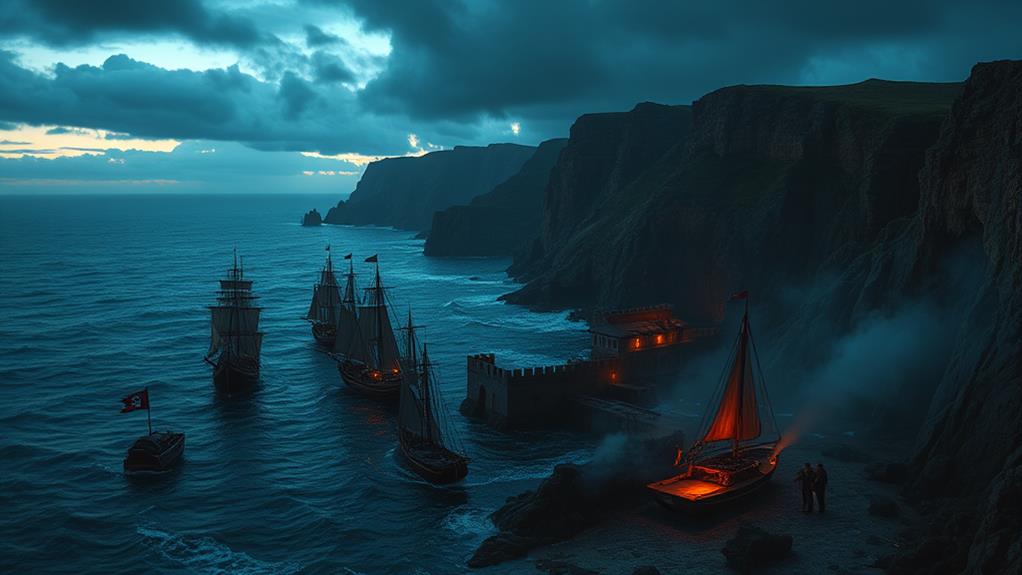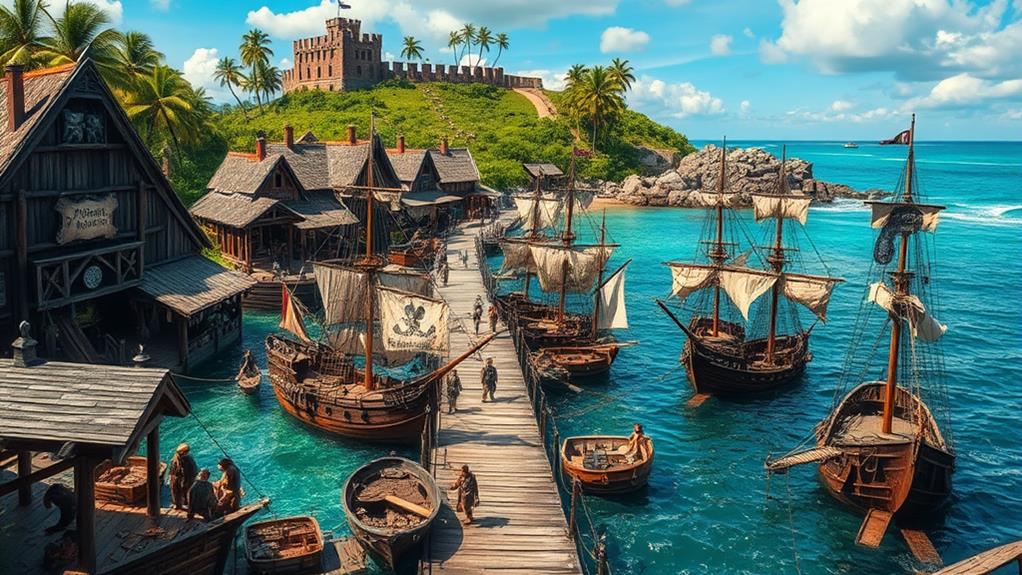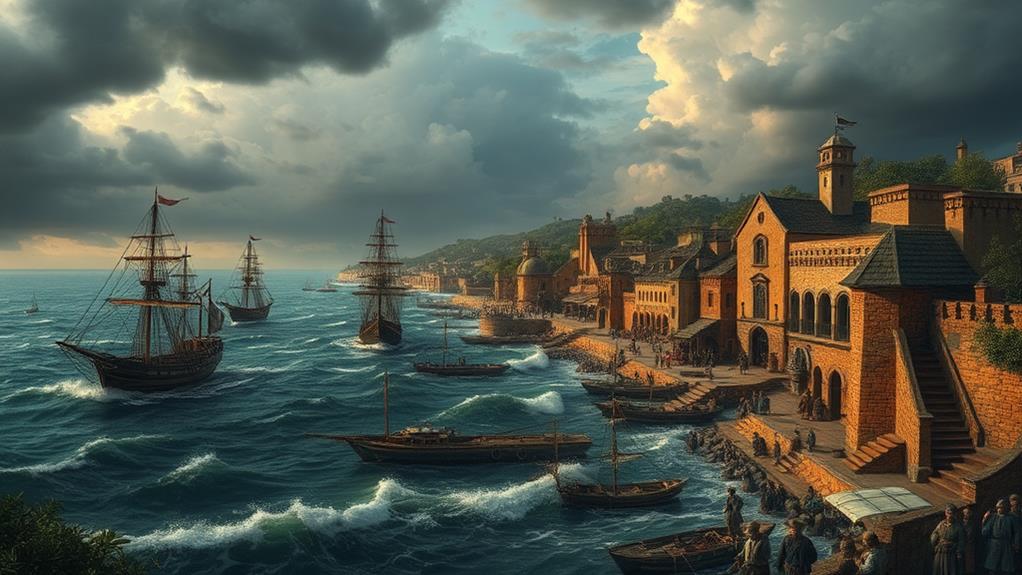
Pirate havens like Port Royal and Tortuga were infamous due to their prime strategic locations near major shipping lanes, making it easy to ambush merchant vessels. These spots thrived in lawless environments where corrupt officials turned a blind eye. Pirates could repair their ships, trade stolen goods, and even run their own makeshift governments. The allure of quick riches from plunder attracted a mix of outlaws, creating bustling, chaotic communities. Places like Nassau flourished until authorities finally intervened. Want to uncover more secrets of these notorious hideaways?
Port Royal, Jamaica

Port Royal, Jamaica, was once known as the "wickedest city on earth." It served as a bustling hub for pirates during the 17th century, attracting infamous figures like Henry Morgan. You'd find this port teeming with activity as ships laden with stolen goods docked, and pirates spent their plunder on drinks, gambling, and other vices. The town's strategic location made it a perfect staging ground for raids on Spanish treasure fleets and settlements in the Americas.
Walking through Port Royal's streets, you'd notice its chaotic energy. Taverns and brothels lined the narrow paths, catering to the rough and rowdy pirate crowd. The local merchants, keen to profit from the influx of wealth, turned a blind eye to the pirates' lawlessness. The combination of easy money and loose morals created an atmosphere of constant revelry and danger.
Port Royal's prosperity didn't last forever, though. In 1692, a catastrophic earthquake and tsunami struck, sinking much of the city into the sea. This disaster marked the end of Port Royal's golden age as a pirate haven. Despite its downfall, the legacy of Port Royal's notorious past still captures the imagination of those fascinated by pirate history.
Tortuga, Haiti
Few pirate havens could rival the infamy of Tortuga, Haiti. Located off the northwestern coast of Hispaniola, Tortuga became a notorious refuge for pirates in the 17th century. Its strategic location made it a perfect launching pad for raids on Spanish ships and settlements. The island's rugged terrain and hidden coves provided excellent hideouts, making it difficult for authorities to capture the elusive buccaneers.
You might wonder what made Tortuga so appealing to pirates. Here are three key factors:
- Strategic Location: Situated near major shipping routes, Tortuga offered easy access to rich plunder from Spanish galleons.
- Lawlessness: The lack of effective governance allowed pirates to operate freely, turning the island into a den of iniquity.
- Diverse Inhabitants: Tortuga attracted a mix of outlaws, privateers, and runaway slaves, creating a melting pot of cultures and skills beneficial for pirate activities.
The island's infamy grew as it became a sanctuary where pirates could repair their ships, trade stolen goods, and revel in their ill-gotten gains. Tortuga's reputation was so fearsome that it inspired countless tales of swashbuckling adventure and lawless escapades that endure to this day.
Nassau, Bahamas

Nestled in the heart of the Caribbean, Nassau, Bahamas, emerged as a pirate stronghold in the early 18th century. You'd find that its strategic location made it a prime spot for pirates looking to intercept merchant ships traveling through the busy trade routes. The shallow waters around Nassau allowed pirates to navigate easily while larger, more cumbersome naval ships struggled.
Here's a quick breakdown of what made Nassau so infamous:
| Feature | Description | Impact on Piracy |
|---|---|---|
| Strategic Location | Positioned on crucial shipping lanes | Enabled easy interception of merchant ships |
| Natural Defenses | Shallow waters and surrounding reefs | Provided safe haven for pirate ships, difficult for naval forces to attack |
| Lack of Governance | Weak British colonial presence and governance | Allowed pirates to operate with little interference |
| Pirate Republic | Informal self-governed pirate community led by figures like Blackbeard | Created a sense of unity and mutual protection among pirates |
In Nassau, pirates found not just a hideaway but a community where they could repair their ships, trade plundered goods, and plan future raids without the constant threat of law enforcement. This pirate republic thrived until the British government finally cracked down in 1718, sending in Woodes Rogers as royal governor to restore order.
Madagascar's Pirate Utopia
While the Caribbean was a well-known pirate stronghold, halfway across the world, Madagascar offered an equally enticing haven for seafaring outlaws. Nestled in the Indian Ocean, this island became a bustling hub for pirates in the late 17th and early 18th centuries, providing a strategic location and abundant resources.
Madagascar wasn't just a hideout; it was a pirate utopia. Here's why it was so infamous:
- Strategic Location: Madagascar's position along the Indian Ocean trade routes made it a prime spot for intercepting merchant ships. Pirates could easily capture valuable goods and retreat to the island's hidden coves and bays.
- Safe Haven: The island's rugged terrain and isolated beaches provided perfect concealment. Pirates could repair their ships, plan their next attacks, and enjoy a relatively safe sanctuary away from the law's reach.
- Pirate Communities: Pirates formed thriving communities here, complete with makeshift governments and shared spoils. They even established trading relationships with local tribes, exchanging loot for fresh supplies and information.
In Madagascar, pirates found more than just a temporary refuge; they discovered a place where they could live freely, away from the rule of law. This utopia, however, would eventually draw the attention of powerful navies, marking the end of its golden age.
The Barbary Coast

Madagascar's pirate utopia might have been a remote haven, but on the other side of the African continent, the Barbary Coast offered another infamous refuge for seafaring outlaws. Stretching from Morocco to modern-day Libya, this rugged coastline became a hotspot for pirates, known as the Barbary corsairs, between the 16th and 19th centuries.
You'd find these pirates operating under the backing of North African rulers, making them a formidable force in the Mediterranean. They didn't just plunder ships; they also engaged in the lucrative slave trade, capturing Europeans and selling them into slavery. Their audacity knew no bounds, and their reach extended as far as Iceland and even the American coast.
The Barbary corsairs' infamy wasn't just in their ruthless tactics but also in their impact on international politics. European nations and the young United States were forced to pay tributes, known as "Barbary tribute," to guarantee safe passage for their ships. If you're thinking about why these pirate havens were so notorious, the Barbary Coast is a prime example. Its blend of ruthless piracy, state sponsorship, and international influence made it a pivotal chapter in the history of piracy.
Saint Mary's Island
Saint Mary's Island, located off the eastern coast of Madagascar, was more than just a tropical paradise; it was a bustling hub for pirates in the 17th and 18th centuries. You'd be intrigued to know that this island wasn't just a hideout but a fully-fledged pirate community. Here's why it became so infamous:
- Strategic Location: Saint Mary's Island's position along key shipping routes made it an ideal spot for intercepting treasure-laden ships traveling between Europe, Africa, and Asia.
- Safe Haven: It provided a secure base where pirates could rest, repair their ships, and share their plunder without the threat of immediate attack from naval forces.
- Pirate Democracy: The island was known for its unique form of governance. Pirates practiced a form of democracy, electing their leaders and dividing the loot fairly among the crew.
Walking through Saint Mary's Island today, you'd discover remnants of its pirate past, including hidden coves and the infamous Pirate Cemetery. The island's history is a legacy to the audacity and resourcefulness of the pirates who once called it home. So, while it may now seem like a serene getaway, its swashbuckling past is never far from the surface.
At a Glance
You've journeyed through the notorious pirate havens, each infamous for its own reasons. Port Royal was like the Wild West of the Caribbean, while Tortuga and Nassau offered lawless freedom. Madagascar's utopia and the Barbary Coast were pirate paradises, and Saint Mary's Island was a bustling rogue hub. Understanding these havens is like deciphering the secrets of history—revealing how pirates shaped their world and ours. Their legends live on, charting the seas of our imagination.





